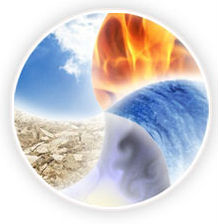Hinduism & science: States of matter (Pancha bhoota)
Hindu scriptures Like Vedas [1700BC-400BC], Ayurveda [~600BC; Charaka, Sushruta Samhitas] Divided Physical existence into a combination of 5 Physical Elements:

- Prithivi (Earth/Solid):
- Jal (Water/Liquid)
- Vaayu (Air/Gaseous)
- Agni (Fire/Plasma)
- Akasha (Space/Ether)
This is the World's oldest division of matter ever into categories.
- The Buddhist Scriptures include the first four states as "Primary" and "Akasha" as the additional state.
- The Charvaka (atheistic) school of Hinduism also doesn't count "Akasha" as it is deemed untangible.
Chronological Estimation of Knowledge of "States of matter" in different Parts of the world
- Indians [1700BC-600BC]: Hindu Scriptures like Vedas (1700-400BC), Ayurveda (~600BC), Charavaka Scriptures (~ 600BC) categorize "States Of matter" into 5. Of which 4 can be felt, and one is to be perceived by attaining a subtle state of mind (which the Charvakas don't agree on).
- Tibetians [Earlier than 500BC]: An old religion of Tibet, which existed before Buddhism entered Tibet called "Bon" lists Five elements same as Indian ones.
- The Greeks [450BC-100BC] : Empedocles(450BC) Listed 4 states of matter. Hermes Trismegistus(300BC),listed 5 "states of matter" which were exactly the same as the Indian ones. There are guesses by prominent Philosophers like Voltaire on the Greeks borrowing Indian concepts during their travelling.
-
"I am convinced that everything has come down to us from the banks of the Ganges, - astronomy, astrology, metempsychosis, etc... It is very important to note that some 2,500 years ago at the least Pythagoras went from Samos to the Ganges to learn geometry...But he would certainly not have undertaken such a strange journey had the reputation of the Brahmins' science not been long established in Europe" [Voltaire, Lettres sur l'origine des sciences et sur celle des peuples de l'Asie (first published Paris, 1777), letter of 15 December 1775.]
-
- The Chinese [200BC-100BC]: Chinese texts talk about 5 Elements, not necessarily "states of Matter". They are
- Metal
- Fire
- Wood
- Water
- Earth
- The Japanese [16th Century]: Japanese have the same states as Indian, it is believed that this knowledge went to Japan along with Buddhism.
- Islamic Golden Age [800AD-1300 AD]: During this time, the states of matter were tested and documented. By that time Islamic world had great access to India and its knowledge
- Modern West [1600 AD]: Though Western Astrology used 4 elements in calculations, proper scientific study of "states of matter" came after the 16th century. At some points "Ether" was recognized and then removed. "Plasma" wasn't always in the list, but only permanently added recently after many scientific confirmations.
Curious Case of Plasma & Ether:
Plasma wasn't considered a state of matter by western scientists for a long time, only Solid, Liquid and Gas were considered proper states. Only recently, after many scientific confirmations is "Plasma" permanently added to the List of states.
Ether was at times considered as a state of matter by the westerners, but it was more of a speculation. Even the Indian scriptures say Ether is not perceivable, though it has physicality to it.
Categories:Hinduism And Science:Topics,
Related content
1. Yoga Vasishta on Human Life Span [topic]
6. Addendum to Evolution: Origins of the World [topic]
7. Bhagavad-Gita Treatise of Self-help [topic]
8. Sundara Kanda Hanuman's Odysey [topic]
9. Promises of Shirdi Sai Baba to his Devotees [topic]
10. Shirdi Sai Baba Name meaning and Origin [topic]
11. Mahabharata Family Tree Chart [topic]
12. Markata Kishora Nyaya, Maarjaala Kishora Nyaya [topic]
14. Lord Ganesha symbolism [topic]
15. What are the ashta (8) Siddhis and nava (9) nidhis [question]